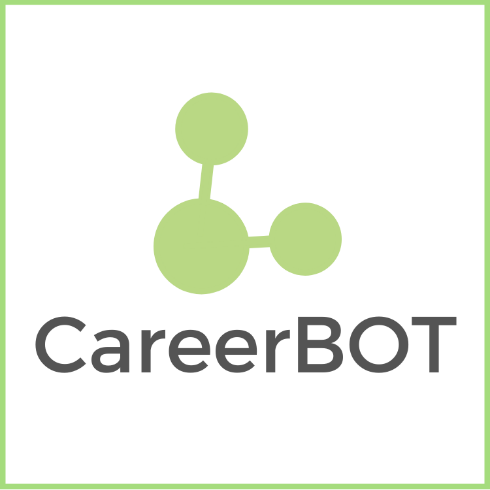Objectives of the CareerBot training
for Career Guidance Practitioners
Main objective of the modular blended learning solution is to provide the competences needed for Career Guidance officers, to use digital guidance tools efficiently. As our initial research demonstrated, there is a huge demand on practical knowledge for career guidance practitioners in digital readiness and digital guidance tools and processes. The CareerBot project offers an experience based approach, where the Bot itself is in the centre and framed by background knowledge on digitalisation tools and processes. The training could be seen as a highly needed addition to existing initial and further educational training programmes for career guidance staff.
The partnership developed the Curriculum and the Training materials for a 18 hours blended learning training, with the following structure:
- 5 Learning Units (LU) designed for self-directed learning
- 7 Learning Units (LU à 45 min.) to be taught face to face or online
- 5 Learning Units (LU) for the transfer into practice
- 1 Learning Units (LU) for the preparation of the final assessment
This curriculum has been tested during the pilot training in October 2023 in Greece: The target group for the first piloting were the Career Guidance practitioners of the implementing partner organisations, who will then train their own colleagues and those of the transfer organisations in each country.
Later, this training program can be implemented in regular further education programs.
The application of the knowledge gathered in the first outcome, Content & Methodology, and the CareerBot tool itself, as well as applied expertise in providing digital and blended guiding sessions, will be a main focus of the blended learning solution.
The CareerBot blended training course
- presents the CareerBot as a supporting element for the practitioners in the advising services
- describes functionalities of the Bot including data protection measures
- identifies motivating strategies to promote the use of the Bot among clients
- trains practitioners in the use of the bot as a supporting element for the quality improvement of their advising services
- presents complementary free digital solutions for the support of guidance services
- presents knowledge on digital transformation of the labor market and green jobs
The role of ECVET in the CareerBot Training
The CareerBot Training Methodology follows the guidelines proposed under the European Credit System for Vocational Credit System for Vocational Education and Training (ECVET) which identifies its key objectives as
- Facilitate the transfer, recognition and accumulation of assessed learning outcomes.
- Support flexible and individualised pathways in education and training.
- Promote lifelong learning.
(The European Credit System for Vocation Education and Training 2021)
While ECVET was reconsidered by the VET Council in 2020 and the initiative has ceased, ECVET objectives and principles remain intertwined in European Vocational Educational Training implementation, and they are very relevant to the implementation of our training methodology.
As a result, the blended CareerBot training curriculum follows the framework of Learning Units – structured in specific Modules – to be completed by trainees (guidance practitioners) through self-directed learning, face to face or online as indicated in the training process chart. This framework enabled partners to build complementing components of the curriculum, which are given in a semi-formal style with active interaction and tangible deliverables at the end via self-assessment and feedback.
In conclusion, the CareerBot training represents a continuing professional development opportunity under lifelong learning principles for career guidance practitioners, including VET educators, teachers, mentors, counsellors and staff, that can implement the new knowledge and competencies acquired with their target groups based on a tailored approach to their beneficiaries needs.
Basic structure of the Training Process
As a prerequisite for applying for our training process, the participant should be an experienced practitioner in Job and Career Counselling (e.g. consultant, trainer, teacher, youth workers, etc.). The CareerBot training is not a career guidance training, but a further training for experienced practitioners who want to learn more about the Bot Tool and the issues of digitalisation and new work opportunities in the field of career guidance.
In practise, this means that all applicants for the training programme must understand the CareerBot approach as described in this document.
Description of the Training Modules
M1: Digital Transformation & Green Jobs
Module 1 is designed for self-learning to provide Career Guidance Practitioners with a collection of information on the topics of digital transformation and green jobs from an European perspective and is supplemented by an extensive collection of links and a bibliography, which serves as a kind of “reference book” that accompanies the practitioners through the entire CareerBot training. Our aim is to offer the practitioners as much background information as possible in order to prepare them optimally for the training with the CareerBot tool in the next modules.
Module 1 offers also exercises to help practitioners to apply what they have learned. Finally, practitioners will discover a checklist on learning outcomes, which they may use to evaluate what they have learnt for themselves.
Although the issues of digitalisation and green jobs frequently overlap, we shall discuss them separately here to provide a clearer picture.
There are two Learning Units in Module 1:
- LU1: Digitalisation in Europe: Opportunities, Challenges, and Impacts
- LU2: Green Jobs in Europe: New Demands and Opportunities


